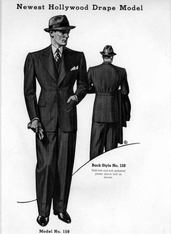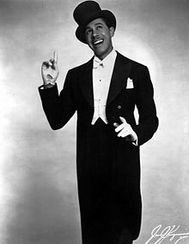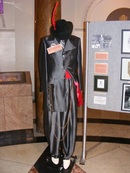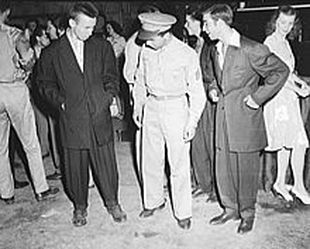|
While I was writing about fashion the second world war in my blog last week, I came across a topic I would like to write little more about: the zoot suit. Many know of the zoot suit through Cab Calloway, who was known for it, and had many varieties. Personally I love the one he was wearing in ‘Stormy Weather’ , the wonderful film with Lena Horn, Bill Robinson (mr Bojangles), the Cotton Club orchestra, Fats Waller, and of course Cab Calloway. A must see if you haven’t already.  What is a zoot suit, and how did this fashion take of? In the thirties high waisted pants, so called slacks, were in fashion. The silhouette was masculine, broad shouldered and narrow waisted. The ‘English drape’ grew popular. London tailor Scholte designed a suit with jackets with wide shoulders and chest, wide armholes and narrow waist, worn with high waisted tapered pants. This look conquered America in the midst of the Great Depression. Hollywood embraced this drape cut. Men Like Gary Grant and Clark Gable wore draped suits. By 1940 the drape style became known as the ‘American cut’. As the Great depression deepened, men started mixing jackets and pants. Menswear changed. Sportswear was common, and especially in World War II men changed their factory overalls for simple T-shirts and slacks instead of suits. The men’s garment industry started manufacturing for young men. Style that adults would never wear. Film and dance also influenced fashion. The Sears catalogue of 1941 offered new wide legged pants called ‘swing pants’ and colors ranging from brown to teal blue and medium green. The drape suit started to evolve. In Harlem there were tailors advertising with ‘extreme English drapes’. Other clothing stores advertised with ’New long drapes’ and adds for pegged pants or ’Jitterbug pants’ started to appear. Photographs of the Savoy ballroom in Harlem show these extreme drape style. In Chicago tailor and trumpeter Harold Fox gained clients with musicians and performers. In his store many jazz musicians gathered because of his costumes and the music was good too. According to Fox the zoot suit was not his invention: It came ‘out of the ghetto’. Young men walked in at tailors and asked for them to make wider and longer jackets, and pegged pants.
 Cab Calloway spread his ‘Jive talk’ and zoot style to musicians in the black community, and also with his white patrons. Soon zoot suits were even worn at the ‘White only’ venues. The name ‘zoot’ could well be deriving from his “Hipsters Dictionary of Jivetalk’ meaning ‘the ultimate’ or ‘exaggerated’. By the early 1940’s the zoot suits became popular with the Mexican youth. In 1943 there were the infamous ‘zoot suit riots’. In Los Angeles, more and more Mexicans took refuge. Together with the war that took away many white men, the jazz scene that openly defied segregation, this caused a lot of racial tension. In 1942 after ‘the sleepy lagoon murder trial’ involving mostly Mexican American men, zoot suited or not, the suit was associated with gangsters and rebels. These riots could well have been called ‘sailor riots’. As they were started by sailors and soldiers who spotted a group of Mexican American women across the street. As they were approaching them, they found a group of zoot suiters in between them. Sailor Coleman claimed he thought he was being attacked, and grabbed the arm of a zoot suited man. Coleman was hit on the head, and from that incident on sailors organised strikes on zoot suiters. The violence continued multiple nights and affected everybody even remotely associated with zoot suits, Mexican youth and jazz. The Los Angeles city counsel approved of criminalising wearing zoot suits with reat pleats. The worst violence was at June the 7th 1943. A Los Angeles paper printed a guide of how to ‘de-zoot’ a zoot suit: “Grab a looter. Take off his pants and frock coat and tear them up and burn them.” That night 500 civilians, sailors, marines and soldiers gathered downtown to go after the Mexicans and African Americas. That year a committee ordered by the governor determined racism to be a central cause of the riots. The Mayor however concluded that juvenile delinquents were the cause, and racial prejudice had nothing to do with it.  So… It was ‘just’ a youth style from the streets. And maybe one of the first to occur in the history of fashion. Others would follow, and certainly nowadays we are used to the idea that street styles first appear in Harlem. Like the jeans that were put on backward, the very low worn pants, cap styles, the zoot suit was merely a street style loved, worn and made famous by dancers and musicians. The zoot suit riots had nothing to do with the suits and were based on racism rather than clothing style. Feel free to wear one, you should only be associated with dancers and musicians. In my mind that is not bad at all! Read more: Zoot suit, The enigmatic Career of an Extreme Style, Kathy Peiss American Experience http://www.pbs.org/wgbh/americanexperience/ Cab Calloway, Hepsters Dictionary For this once, I had to put in two video's.
2 Comments
24/2/2015 12:09:44 pm
1944 Jazz At The Philharmonic
Reply
Sunny
24/2/2015 01:08:38 pm
Thanks for adding this Porl! What a great way to promote integration.
Reply
Your comment will be posted after it is approved.
Leave a Reply. |
Sunny van Zijst
I am maker of vintage inspired couture. I was trained as a designer for theater costumes. Now I enjoy making vintage inspired clothing for men and women. Archives
July 2023
|



 RSS Feed
RSS Feed
